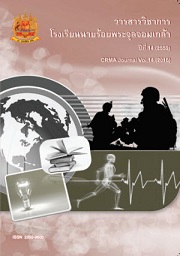การเปรียบเทียบความแม่นยำและประสิทธิภาพระหว่างการสุ่มแบบชั้นภูมิสองขั้นตอนและการสุ่มแบบกริด
Main Article Content
บทคัดย่อ
วิธีการสุ่มตัวอย่างแบบชั้นภูมิได้รับการยอมรับว่ามีความแม่นยำที่สุดสำหรับงานวิจัยเชิงพฤติกรรมศาสตร์และสังคมศาสตร์ ในขณะที่วิธีการสุ่มแบบกริดเป็นวิธีการสุ่มที่แพร่หลายสำหรับงานวิจัยทางด้านวิทยาศาสตร์กายภาพที่ศึกษาวิจัย ในกรณีที่ประชากรมีจำนวนมากและอาศัยในพื้นที่ขนาดใหญ่ ดังนั้นเอกสารวิจัยฉบับนี้จะทำการเปรียบเทียบความแม่นยำและประสิทธิภาพระหว่างการสุ่มแบบชั้นภูมิสองขั้นตอนและการสุ่มแบบกริด โดยใช้ฐานข้อมูลของคะแนนการทดสอบทางการศึกษาระดับชาติขั้นพื้นฐาน Ordinary National Educational Test (O-NET) ปีการศึกษา 2548 จากโรงเรียนต่างๆ ทั่วประเทศไทย จำนวนทั้งหมด 2,584 โรงเรียน มีค่าเฉลี่ยเท่ากับ 161.67 คะแนน และส่วนเบี่ยงเบนเท่ากับ 21.74 คะแนน จากนั้นสุ่มกลุ่มตัวอย่างจำนวน 335 โรงเรียนด้วยวิธีการสุ่มตัวอย่างแบบชั้นภูมิสองขั้นตอน มีค่าเฉลี่ยเท่ากับ 156.56 คะแนน และส่วนเบี่ยงเบนเท่ากับ 15.81 คะแนน และเมื่อใช้วิธีการสุ่มแบบกริด มีค่าเฉลี่ยเท่ากับ 158.49 คะแนน และส่วนเบี่ยงเบนเท่ากับ 16.51 คะแนน จากผลการวิเคราะห์พบว่าวิธีการสุ่มตัวอย่างทั้งสองวิธีมีความแม่นยำทางสถิติไม่แตกต่างกัน แต่วิธีสุ่มแบบกริดมีประสิทธิภาพมากกว่า เนื่องจาก กลุ่มตัวอย่างที่ได้จากวิธีการสุ่มแบบชั้นภูมิสองขั้นตอนมีการกระจายตัว แต่วิธีการสุ่มแบบกริดมีตำแหน่งของกลุ่มตัวอย่างที่เกาะกลุ่มกันบริเวณรอบตำแหน่งจุดกริด ซึ่งประหยัดทรัพยากรและสะดวกในการเก็บรวบข้อมูล
Article Details
ผลงานที่ได้รับการตีพิมพ์ ถือเป็นลิขสิทธิ์ของวารสารฯ
เอกสารอ้างอิง
ธัญลักษณ์ เหลืองวิสุทธิ์, 2540. โพล : การเมืองของการวิจัยเชิงสำรวจ. วิทยานิพนธ์รัฐศาสตรมหาบัณฑิต, มหาวิทยาลัย ธรรมศาสตร์.
สุชาดา บวรกิติวงศ์, 2548. สถิติประยุกต์ทางพฤติกรรมศาสตร์. กรุงเทพมหานคร : สำนักพิมพ์จุฬาลงกรณ์มหาวิทยาลัย.
ศิริชัย กาญจนวาสี, 2545. หนังสือสถิติประยุกต์สำหรับการวิจัย. (พิมพ์ครั้งที่ 3). กรุงเทพฯ : ภาควิชาวิจัยการศึกษา คณะครุศาสตร์ จุฬาลงกรณ์มหาวิทยาลัย.
กลุ่มระเบียบวิธีสถิติ สํานักนโยบายและวิชาการสถิติ สํานักสถิติแห่งชาติ., ม.ป.ป. เทคนิคการสุ่มตัวอย่างและการประมาณค่า. เข้าถึงได้จาก [Online] http://service.nso.go.th/nso/nsopublish/Toneminute/files/55/A3-16.pdf
มนตรี พิริยะกุล, 2530. เทคนิคการสำรวจด้วยกลุ่มตัวอย่าง. (พิมพ์ครั้งที่ 4). กรุงเทพฯ : ห้างหุ้นส่วนจำกัด ป. สัมพันธ์พาณิชย์.
Mallarino, A.P., and Witty, D., 2001. Management zones soil sampling: A better alternative to grid and soil type sampling?. In The Integrated Crop Management Conf. Proceedings. Dec. 5-6, 2001, : 159-164.
Dinkins, C.P., and Jones, C., 2008. Soil Sampling Strategies. [Online]http://landresources.montana.edu/soilfertility/PDFbyformat/publication%20pdfs/Soil_Sampling_Strat_MT200803AG.pdf
Midwest Laboratories, 2009. Soil Sampling Methods. [Online] http://agrienergy.net/docs/lab-information/soil-sampling.pdf
ศูนย์ปฏิบัติการ GPA สำนักทดสอบทางการศึกษา สพฐ., 2549. รายงานคะแนน O-Net และผลการเรียนเฉลี่ย (GPA) ปีการศึกษา 2548 [Online] http://www.nkw.ac.th/onet/onet48allsc.htm
Krejcie, R.V., and Morgan, D.W., 1970. Determining Sample Size for Research Activities. Educational and Psychological Measurement. 30(3) : 607-610.
Neuman, W. L., 1991. Social research methods: qualitative and quantitative approaches. Boston : Allyn and Bacon.
Dong-Sheng, Y., Zhong-Qi, Z., Hao, Y., Xue-Zheng, S., Man-Zhi, T., Wei-Xia, S., & Hong-Jie, W., 2011. Effect of soil sampling density on detected spatial variability of soil organic carbon in a red soil region of China. Pedosphere, 21(2) : 207–213.
Majasalmi, T., Rautiainen, M., Stenberg, P., & Rita, H., 2012. Optimizing the sampling scheme for LAI-2000 measurements in a boreal forest. Agricultural and Forest Meteorology, 154– 155 : 38– 43.


